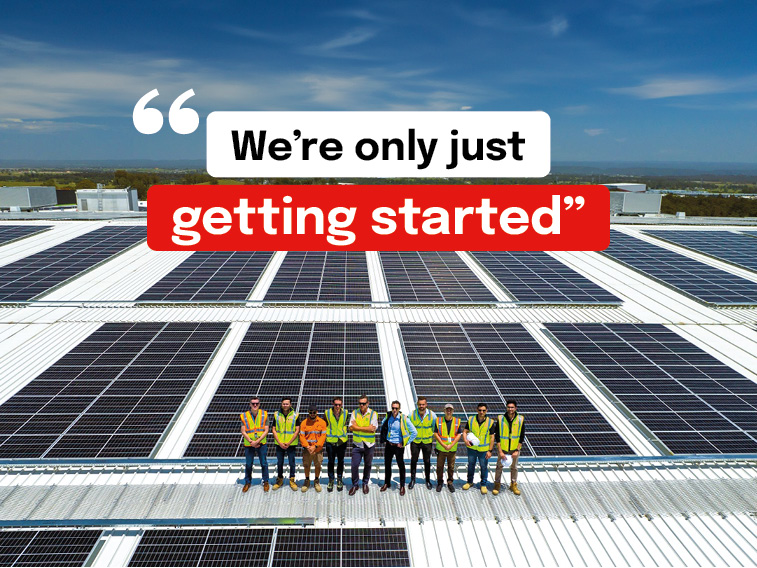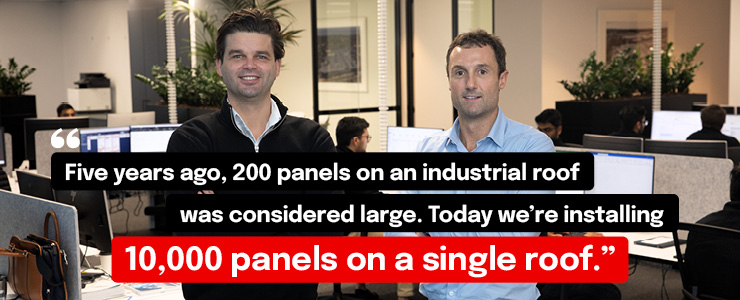Firmer consumer and steady outlook


Insight
Australia’s commercial rooftop solar power industry is experiencing unprecedented growth, transforming how energy is consumed and generated across the nation. And according to Energy Aware Managing Director Tim Parkinson, “we’re only just getting started.”

One word can describe the growth of Australia’s solar industry – supercharged.
It’s a success story written on rooftops around the country. From homes to shopping malls to warehouses, rooftop solar generation capacity has surpassed 20GW as of 2023, making it the fourth largest source of electricity generation, according to the Clean Energy Council. With no sign of a slowdown, the Australian Energy Market Operator predicts this capacity will increase to 72GW by 2050.
Financially, rooftop solar is now such a straightforward decision that commercial and industrial property developers factor it into the design stage. Simultaneously, the sophistication and scale of solar installations have taken a giant leap forward, leading to larger and more complex systems.
“Five years ago, 200 panels on a commercial roof was considered a large system,” explains Energy Aware Managing Director Tim Parkinson.
“Today, we are being engaged by builders to install 10,000 panels on a single roof.”
The rise in demand for ecommerce, as well as new business and operational models in the fast-moving consumer goods, supermarket, food manufacturing and logistics sectors, means that tenants are scrambling to secure space in new-build warehouses and distribution centres. And with that comes large-scale solar installations.
“We’ve long specialised in this area, so we’ve grown alongside it,” says Energy Aware Sales Director Nick Burrows. “As the commercial and industrial construction sector has matured and shifted towards energy efficiency, we’ve positioned ourselves as a solar supplier of choice and become the second-largest commercial installer in Australia.
“Our projects are consistently expanding in scale. As they have grown, we’ve continuously evolved our methods to keep pace with the construction industry’s advancing needs.”

Contemporary warehouses are designed and built with automation in mind, which requires planning for electricity supply. Perhaps even more importantly, developers, builders and tenants are all much more conscious of their energy needs, and informed about the options available to them.
“Clients come to us with deep knowledge of their energy requirements and the benefits of solar,” Nick says. “They’re sophisticated users who want to incorporate those needs into the design, from the start.
“We bring an in-house team with construction and design expertise so we can get involved early in the process and optimise the operational, financial and environmental benefits. It’s no longer about simply retrofitting a warehouse with a few panels to cut costs – we’re now integrating comprehensive solar solutions from the ground up.”
Among other factors driving solar industry growth are increasingly rigorous building standards and certifications, like NABERS and Green Star ratings, which mean that developers are incorporating energy generation and efficiency into a building’s design.
Tenants often have mandated or voluntary commitments to ESG frameworks and net-zero timelines, and are more conscious of their environmental impact in general. And consumers are increasingly making purchasing decisions with a keen eye on the sustainability of businesses, providing a potential market advantage to those businesses choosing solar power.

From a cost-benefit perspective, Tim believes the decision to invest in solar power has never been more straightforward. Supportive government policies have significantly smoothed the path to adoption.
“We’re now at a point where the primary consideration isn’t just the payback period; it’s about how solar can holistically enhance your business, from better building design to operational efficiency.”
“The industry’s challenge and opportunity are to push the boundaries of solar roof coverage, creating buildings that not only produce their own energy but also interact seamlessly with microgrids and peer-to-peer networks.”
As new technology comes onto the market and designs continue to advance, Energy Aware expects that innovation will continue to change the way warehouses are designed and built. Logistics centres are increasingly structured around a growing electrified transport fleet, often large enough that it becomes difficult to charge directly from the grid.
“Smart operators are forward-planning and future-proofing their sites against the need for additional power for electric fleets,” Nick says.
“As the cost curve of batteries continues to come down – just as we saw with solar panels over the past decade – they’ll increasingly be an element of the design stage.”
For some, that will involve incorporating sophisticated battery techniques such as arbitraging wholesale energy prices or utilising batteries for grid stability programs to generate alternate revenue streams. Moving forward, the financial benefits of commercial batteries will be substantial, making them a necessary complement to the building’s solar installation, according to Tim.
“It’s a very exciting time for Australia’s commercial and industrial solar sector,” Tim says. “And we’re only just getting started.”

© National Australia Bank Limited. ABN 12 004 044 937 AFSL and Australian Credit Licence 230686.